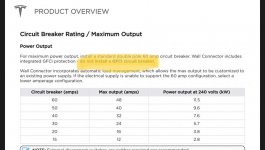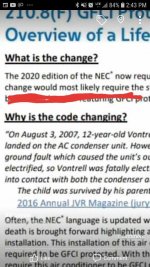Bill Snyder
NEC expert
- Location
- Denver, Co
- Occupation
- Electrical Foreman
A listed Class A GFCI shall provide protection in accordance with 210.8(A) through (F). The GFCI shall be installed in a readily accessible location.
Informational Note: See 215.9 for GFCI protection on feeders.
For the purposes of this section, the distance from receptacles shall be measured as the shortest path the power supply cord connected to the receptacle would follow without piercing a floor, wall, ceiling, or fixed barrier. Add a new Exception No. 5 to section 210.8(A) to read as follows: 210.8(A) Dwelling Units. … Exception No. 5: GFCI protection shall not be required for a receptacle serving a refrigerator or HVAC appliance if all of the following conditions are met: (1) The appliance is located within a dedicated space. (2) The appliance is on an individual branch circuit. (3) In normal use, the appliance is not easily moved or is fastened in place. This exception shall expire January 1, 2028.
Exception #2 If any of the specific equipment has integral protection for personnel provided by the manufacturer and compliant with the UL standard.
Additional Proposed Changes
Statement of Problem and Substantiation for Public Input
There has been a growing number of incompatibility issues with specific equipment and it would seem that the UL standard for testing and safety would meet the minimum requirements of the NEC. I feel this must be addressed due to the fact if a piece of equipment does not function with a class A device, the class A device is removed and standard OCPD is used. A scenario where the equipment is not listed in 210.8(D) and hardwired the hazard to personnel is removed by removing the receptacle.
Informational Note: See 215.9 for GFCI protection on feeders.
For the purposes of this section, the distance from receptacles shall be measured as the shortest path the power supply cord connected to the receptacle would follow without piercing a floor, wall, ceiling, or fixed barrier. Add a new Exception No. 5 to section 210.8(A) to read as follows: 210.8(A) Dwelling Units. … Exception No. 5: GFCI protection shall not be required for a receptacle serving a refrigerator or HVAC appliance if all of the following conditions are met: (1) The appliance is located within a dedicated space. (2) The appliance is on an individual branch circuit. (3) In normal use, the appliance is not easily moved or is fastened in place. This exception shall expire January 1, 2028.
Exception #2 If any of the specific equipment has integral protection for personnel provided by the manufacturer and compliant with the UL standard.
Additional Proposed Changes
| File Name | Description | Approved | |||
|---|---|---|---|---|---|
| Open | 315522135_562375592318221_2186616584159142738_n.jpg | Tesla Manufacturer instructions | ✓ | ||
| Open | 358395649_3488271048114890_8514449395977391969_n.jpg | Massachusetts local amendment for compatibility exception | ✓ |
There has been a growing number of incompatibility issues with specific equipment and it would seem that the UL standard for testing and safety would meet the minimum requirements of the NEC. I feel this must be addressed due to the fact if a piece of equipment does not function with a class A device, the class A device is removed and standard OCPD is used. A scenario where the equipment is not listed in 210.8(D) and hardwired the hazard to personnel is removed by removing the receptacle.



